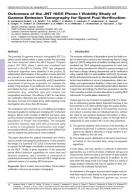Details
- Identification
- ISSN: 1977-5296, DOI: 10.3011/ESARDA.IJNSNP.2017.14
- Publication date
- 1 December 2017
- Author
- Joint Research Centre
Description
Volume: 55, December 2017, pages 10-28,
Authors: S. Jacobsson Svärd1, L.E. Smith2, T.A. White2,7, V. Mozin3, P. Jansson1, P. Andersson1, A. Davour1, S. Grape1, H. Trellue4, N. Deshmukh2, E.A. Miller2, R. S. Wittman2, T. Honkamaa5, S. Vaccaro6, J. Ely7
1Uppsala University, 2Pacific Northwest National Laboratory, 3Lawrence Livermore National Laboratory, 4Los Alamos National Laboratory, 5STUK – Radiation and Nuclear Safety Authority, 6European Commission, Directorate General Energy, Directorate Euratom Safeguards, 7International Atomic Energy Agency (IAEA)
Abstract:
The potential for gamma emission tomography (GET) to detect partial defects within a spent nuclear fuel assembly has been assessed within the IAEA Support Program project JNT 1955, phase I, which was completed and reported to the IAEA in October 2016. Two safeguards verification objectives were identified in the project; (1) independent determination of the number of active pins that are present in a measured assembly, in the absence of a priori information about the assembly; and (2) quantitative assessment of pin-by-pin properties, for example the activity of key isotopes or pin attributes such as cooling time and relative burnup, under the assumption that basic fuel parameters (e.g., assembly type and nominal fuel composition) are known. The efficacy of GET to meet these two verification objectives was evaluated across a range of fuel types, burn ups and cooling times, while targeting a total interrogation time of less than 60 minutes.
The evaluations were founded on a modelling and analysis framework applied to existing and emerging GET instrument designs. Monte Carlo models of different fuel types were used to produce simulated tomographer responses to large populations of “virtual” fuel assemblies. The simulated instrument response data were then processed using a variety of tomographic-reconstruction and image processing methods, and scoring metrics were defined and used to evaluate the performance of the methods.
This paper describes the analysis framework and metrics used to predict tomographer performance. It also presents the design of a “universal” GET (UGET) instrument intended to support the full range of verification scenarios envisioned by the IAEA. Finally, it gives examples of the expected partial-defect detection capabilities for some fuels and diversion scenarios, and it provides a comparison of predicted performance for the notional UGET design and an optimized variant of an existing IAEA instrument.
Keywords: Spent nuclear fuel assemblies; Partial defect verification; Gamma-ray emission tomography
Reference guideline:
Jacobsson Svärd, S., Smith, L.E., White, T.A., Mozin, V., Jansson, P., Andersson, P., Davour, A., Grape, S., Trellue, H., Deshmukh, N., Miller, E.A., Wittman, R.S.,
Honkamaa, T., Vaccaro, S., & Ely, J. (2017). Outcomes of the JNT 1955 Phase I Viability Study of Gamma Emission Tomography for Spent Fuel Verification. ESARDA Bulletin - The International Journal of Nuclear Safeguards and Non-proliferation, 55, 10-28. https://doi.org/10.3011/ ESARDA.IJNSNP.2017.14

